On March 24, 1999 the NATO military operation against the Federal Republic of Yugoslavia began. The operation sought to stop human rights abuses in Kosovo, but was not authorized by the UN. The airstrikes lasted until June 10, 1999. The NATO bombing campaign marked the second major combat operation in its history, following the 1995 NATO bombing campaign in Bosnia and Herzegovina. The 1999 operation resulted in the withdrawal of Yugoslav forces from Kosovo and the establishment of UNMIK, a UN mission in Kosovo.
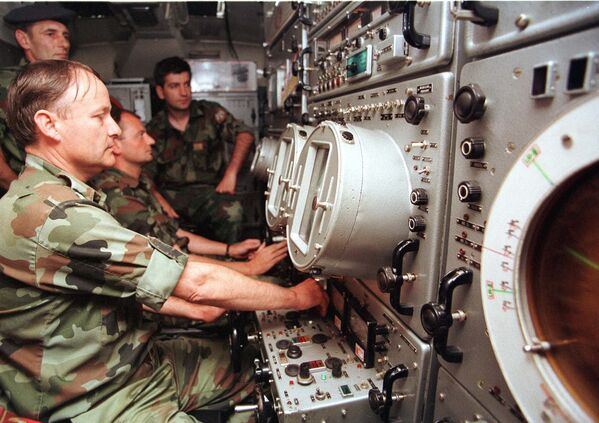
1/16
© AP Photo / STR
The official NATO codename was Operation Allied Forces. The United States called it Operation Noble Anvil. In some sources it is incorrectly called "Merciful Angel".
Above: A Yugoslav anti-aircraft crew manning a mobile radar unit, near Belgrade, in this filer taken July 1998.
Above: A Yugoslav anti-aircraft crew manning a mobile radar unit, near Belgrade, in this filer taken July 1998.
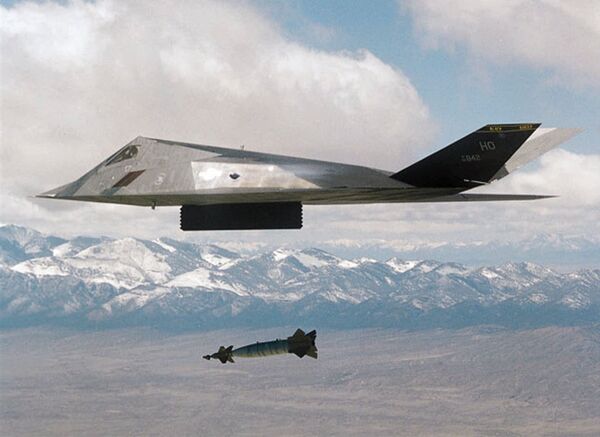
2/16
© AP Photo / U.S. Air Force, Msgt. Keith Reed
The reason behind the international military intervention was an ethnic conflict between Albanians and Serbs in Kosovo. On September 23, 1998, the UN Security Council adopted resolution 1199 which urged the authorities of the Federal Republic of Yugoslavia and Kosovar Albanians to cease fire immediately and begin peace talks.
Above: An undated photo of an F-117 Nighthawk aircraft. A US stealth fighter was lost over Yugoslavia on the evening of March 27, 1999.
Above: An undated photo of an F-117 Nighthawk aircraft. A US stealth fighter was lost over Yugoslavia on the evening of March 27, 1999.
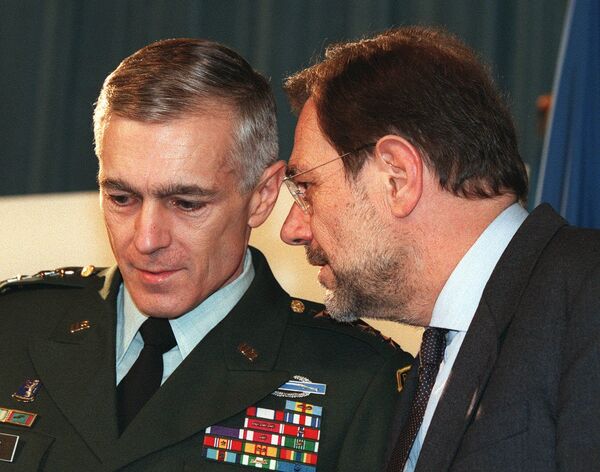
3/16
© AP Photo / Peter Dejong
The situation escalated after an incident in the village of Racak on January 15, 1999 when major armed clashes took place between Yugoslavian security forces and militants of the Kosovo Liberation Army. Forty-five people were reported to have been killed in the incident.
Above: Gen. Wesley Clark (L), NATO's top commander, listens to NATO Secretary-General Javier Solana prior to a joint news conference at NATO headquarters in Brussels, Belgium on Thursday, March 25, 1999.
Above: Gen. Wesley Clark (L), NATO's top commander, listens to NATO Secretary-General Javier Solana prior to a joint news conference at NATO headquarters in Brussels, Belgium on Thursday, March 25, 1999.
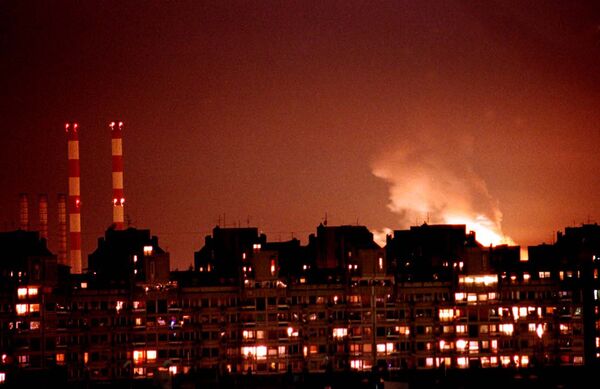
4/16
© AP Photo / Dimitri Messinis
On March 24, 1999, NATO started a military operation against Yugoslavia which was not authorized by the UN Security Council. The decision to start the bombings was made by NATO’s then-Secretary General Javier Solana.
Above: Flames from an explosion light up the Belgrade skyline near a power station after NATO cruise missiles and warplanes attacked Yugoslavia late Wednesday, March 24, 1999.
Above: Flames from an explosion light up the Belgrade skyline near a power station after NATO cruise missiles and warplanes attacked Yugoslavia late Wednesday, March 24, 1999.
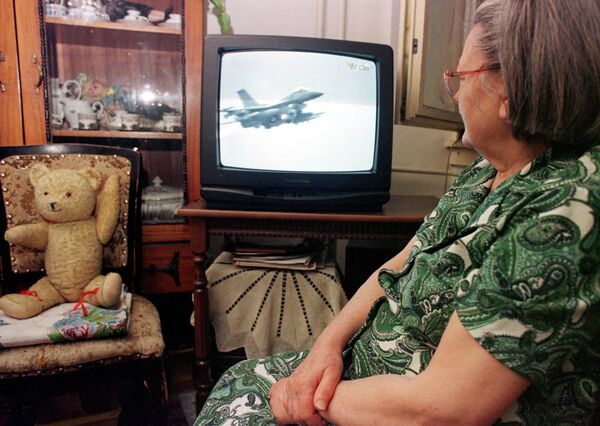
5/16
© AP Photo / Amel Emric
A presence of Serbian forces on the territory of the Autonomous Province of Kosovo and Metohija was declared the official reason for the military operation. The Serbian authorities were also accused of ethnic cleansings.
Above: An unidentified Bosnian woman watches NATO air strikes against Yugoslav military targets on a TV screen in Tuzla, Bosnia, on Wednesday, March 25, 1999.
Above: An unidentified Bosnian woman watches NATO air strikes against Yugoslav military targets on a TV screen in Tuzla, Bosnia, on Wednesday, March 25, 1999.
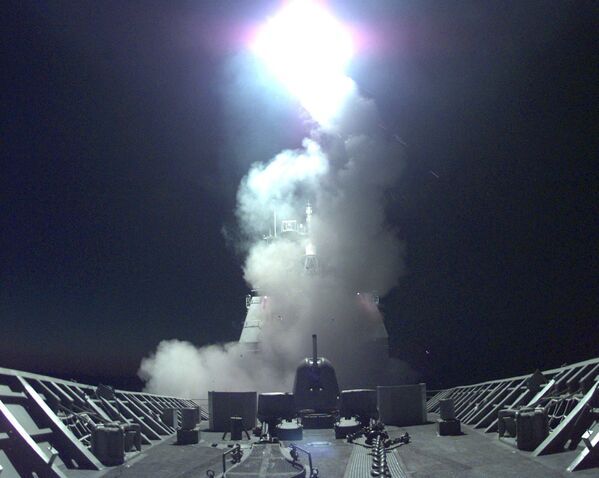
Thirteen NATO member countries provided aircraft for the operation including France, Germany, Italy, Norway, Portugal, Spain, Turkey, Britain and the US. American forces made up 75 percent of the NATO forces engaged in the operation.
Above: A Tomahawk cruise missile launches from the bow of the US Navy cruiser USS Philippine Sea at targets throughout Yugoslavia and Kosovo on March 24, 1999.
Above: A Tomahawk cruise missile launches from the bow of the US Navy cruiser USS Philippine Sea at targets throughout Yugoslavia and Kosovo on March 24, 1999.
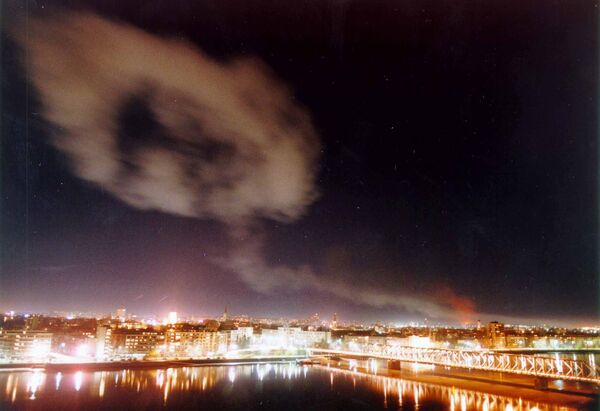
7/16
© AP Photo / str
On the day the operation began, NATO offensive forces consisted of 277 aircraft, including 192 bombers, 63 logistic support planes, 19 reconnaissance planes and three helicopters.
Above: Smoke billows over the northern Yugoslav city of Novi Sad, some 70 kilometers north of Belgrade after NATO air raids late Wednesday, March 24, 1999.
Above: Smoke billows over the northern Yugoslav city of Novi Sad, some 70 kilometers north of Belgrade after NATO air raids late Wednesday, March 24, 1999.
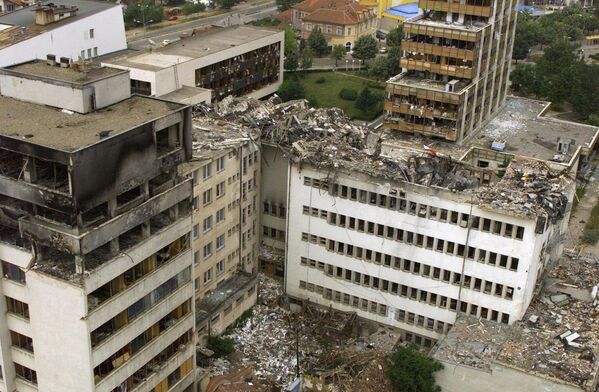
The first airstrikes were conducted on March 24 at 20:00 local time against radar stations of Yugoslav forces located at the Montenegrin coast of the Adriatic Sea. At the same time, missile strikes were conducted against a military airfield near Belgrade and manufacturing facilities in the city of Pancevo, 20 kilometers north of the capital of Yugoslavia.
Above: An aerial view taken June 15, 1999 of the Pristina central post office which was destroyed by NATO bombing.
Above: An aerial view taken June 15, 1999 of the Pristina central post office which was destroyed by NATO bombing.
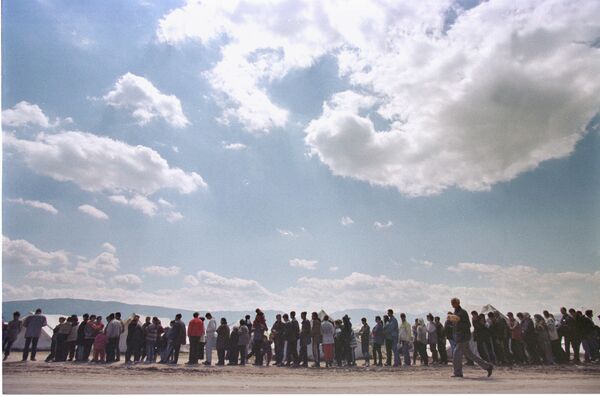
9/16
© AP Photo / Peter Dejong
A total of 53 targets were destroyed during the operation. In most large cities of Serbia and Montenegro martial law was declared for the first time since World War II.
Above: A line of Kosovar refugees queue for food under a sunny sky at the NATO-run camp at Stenkovec, near Skopje, Monday, April 19, 1999.
Above: A line of Kosovar refugees queue for food under a sunny sky at the NATO-run camp at Stenkovec, near Skopje, Monday, April 19, 1999.
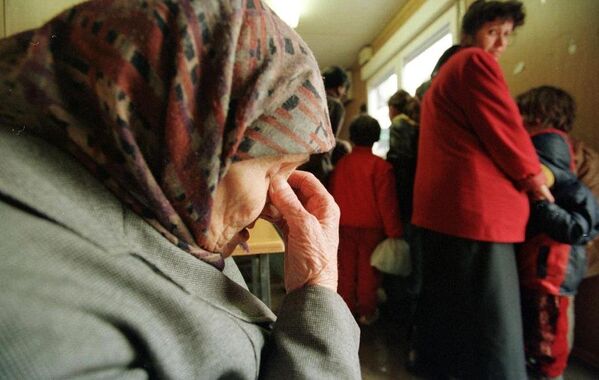
During the first month of Operation Allied Force, NATO conducted 350 air campaigns a day. At the NATO summit in Washington on April 23, 1999, leaders of the alliance decided to intensify the bombing campaign.
Above: An elderly ethnic Albanian woman looks in pain as she arrives in Blace, at the border in Macedonia, 25 km north of Skopje, March 27, 1999, following NATO's air strikes against Yugoslavia.
Above: An elderly ethnic Albanian woman looks in pain as she arrives in Blace, at the border in Macedonia, 25 km north of Skopje, March 27, 1999, following NATO's air strikes against Yugoslavia.
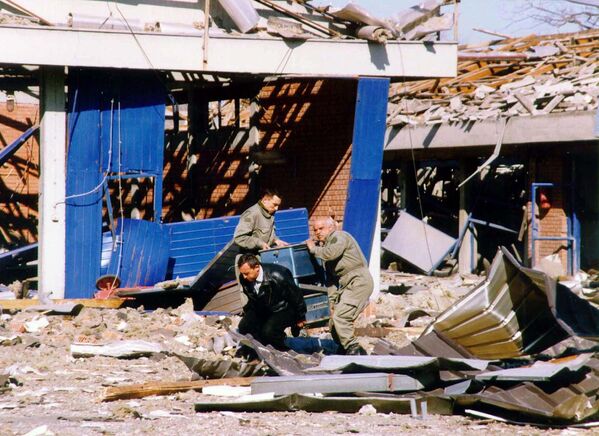
During the operation NATO forces conducted a total of 37,500-38,400 combat flights and attacked over 900 targets in Serbia and Montenegro. More than 21,000 tons of bombs were used. During the airstrikes prohibited projectiles with radioactive elements (mostly with depleted uranium U 238) were used.
Above: Workers clean the debris of a police training center which was destroyed during NATO airstrikes in Novi Sad, in the north of Yugoslavia, on March 25, 1999.
Above: Workers clean the debris of a police training center which was destroyed during NATO airstrikes in Novi Sad, in the north of Yugoslavia, on March 25, 1999.
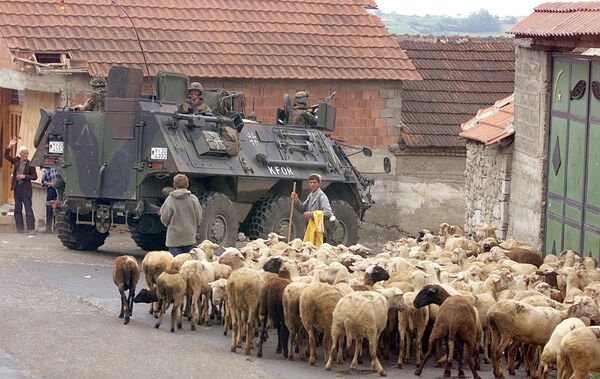
When the military campaign began the parliament of the Federal Republic of Yugoslavia voted for joining the union of Russia and Belarus. Then-president of Russia Boris Yeltsin blocked the process because it could provoke a series of international problems.
Above: A German armored vehicle part of the NATO-led KFOR troops drives past a herd of sheep June 17, 1999 in Orahovac, southwestern Kosovo.
Above: A German armored vehicle part of the NATO-led KFOR troops drives past a herd of sheep June 17, 1999 in Orahovac, southwestern Kosovo.
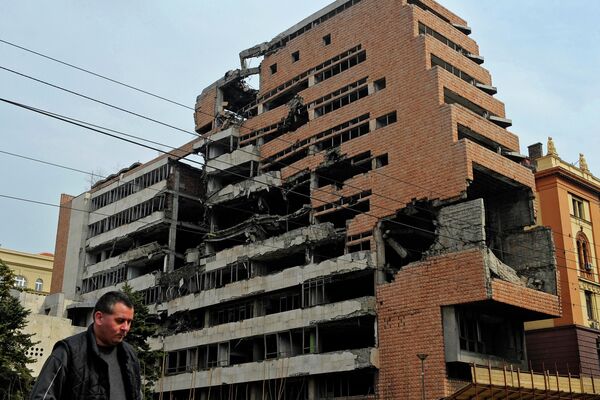
The bombings stopped on June 9, 1999 following the signing of a treaty in the city of Kumanovo by representatives of Yugoslavia and NATO on the withdrawal of Yugoslavian troops and police forces from Kosovo and the deployment of international forces in the region.
Above: A man walks past the building of the former federal military headquarters in Belgrade on March 24, 2010, destroyed during the 1999 NATO air campaign against Yugoslavia.
Above: A man walks past the building of the former federal military headquarters in Belgrade on March 24, 2010, destroyed during the 1999 NATO air campaign against Yugoslavia.
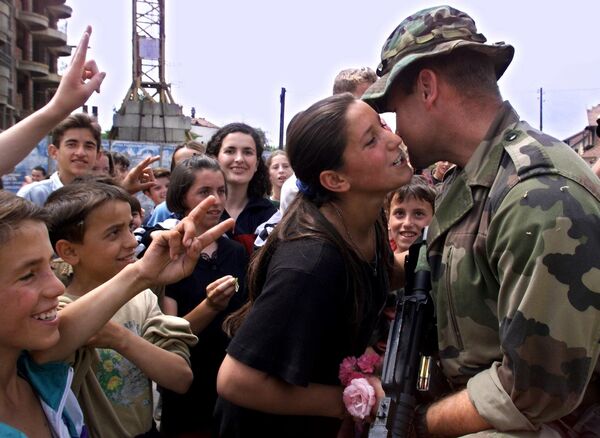
The precise number of military personnel and civilians killed during the bombings is still unknown. According to the Serbian government, the airstrikes killed nearly 2,500 people, including 89 children. Both Serbs and Albanians were killed in 90 Human Rights Watch-confirmed incidents in which civilians died as a result of NATO bombing. According to NATO, two of its soldiers were killed in the operation.
Above: A French soldier with the NATO peacekeeping force for Kosovo (KFOR) is welcomed by ethnic Albanians in the northern Kosovar city of Mitrovica onJune 15, 1999.
Above: A French soldier with the NATO peacekeeping force for Kosovo (KFOR) is welcomed by ethnic Albanians in the northern Kosovar city of Mitrovica onJune 15, 1999.
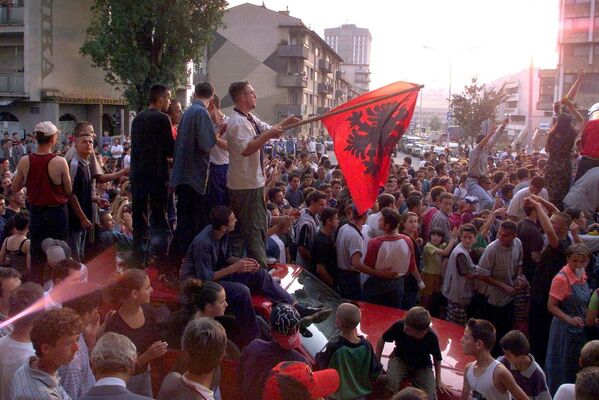
Around 863,000 people, mostly Kosovar Serbs, fled the region. Some 590,000 were displaced.
Above: About 1,000 young Kosovar Albanians celebrate the "UCK [Kosovo Liberation Army] victory over the Serbs with NATO's help" in the center of Pristina July 2, 1999, marking the ninth anniversary of the declaration of independence by Kosovars.
Above: About 1,000 young Kosovar Albanians celebrate the "UCK [Kosovo Liberation Army] victory over the Serbs with NATO's help" in the center of Pristina July 2, 1999, marking the ninth anniversary of the declaration of independence by Kosovars.
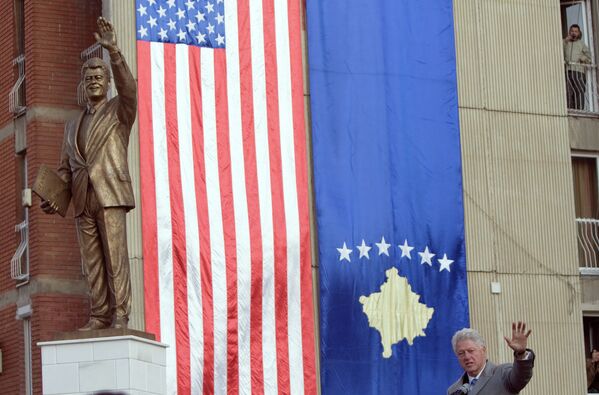
16/16
© AP Photo / Visar Kryeziu
On June 10, 1999 the UN Security Council adopted resolution 1244 which authorized an international civil and military presence in Kosovo. On June 12 the first units of international forces led by NATO – KFOR (Kosovo Force) - entered the region.
Above: Former US President Bill Clinton waves to thousands of ethnic Albanians as he stands beside a statue of himself in Pristina, Kosovo, on Sunday, November 1, 2009.
Above: Former US President Bill Clinton waves to thousands of ethnic Albanians as he stands beside a statue of himself in Pristina, Kosovo, on Sunday, November 1, 2009.

